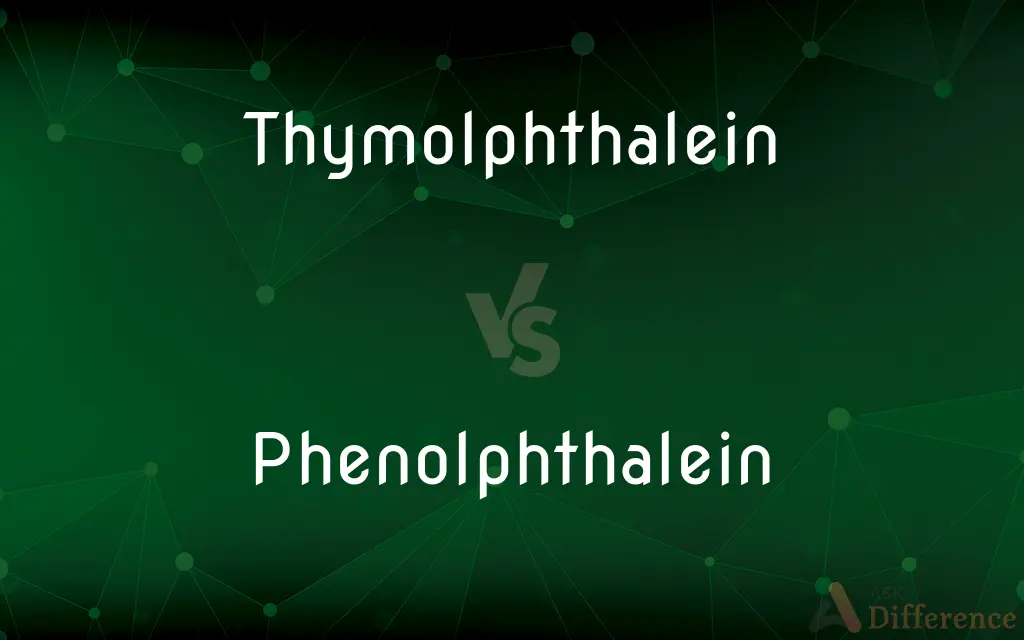Thymolphthalein vs. Phenolphthalein — What's the Difference?
By Tayyaba Rehman — Published on October 25, 2023
Thymolphthalein and Phenolphthalein are both pH indicators; Thymolphthalein is colorless in acidic and blue in basic solutions, while Phenolphthalein is colorless in acidic and pink in basic solutions.

Difference Between Thymolphthalein and Phenolphthalein
Table of Contents
ADVERTISEMENT
Key Differences
Thymolphthalein and Phenolphthalein serve pivotal roles in chemistry as pH indicators, yet they diverge in their color changes and pH ranges of activity. Thymolphthalein shifts from colorless under acidic conditions to blue in basic (approximately pH 9.3-10.5). On the contrary, Phenolphthalein transitions from colorless in acidic environments to pink in basic conditions, effective in a pH range around 8.2 to 10.0.
While Thymolphthalein predominantly finds its usage in scientific explorations, sometimes in educational settings to visualize acid-base reactions, Phenolphthalein has been historically exploited not only in laboratories but also in various commercial products. Phenolphthalein was once a component in over-the-counter laxatives, while Thymolphthalein has not found such widespread use in consumer products.
Thymolphthalein and Phenolphthalein, although sharing fundamental purposes as pH indicators, exhibit their own unique chemical structures and properties. The molecular architecture of Thymolphthalein is distinguished by its own pattern of atoms and bonds that afford its particular color-changing ability. Phenolphthalein, while sharing a semblance in structure due to its phthalein backbone, embodies its own unique molecular arrangement, enabling its distinctive color transition.
The application of Thymolphthalein might be considered somewhat narrower in comparison to Phenolphthalein due to the latter’s historical prevalence in both scientific and commercial spheres. Phenolphthalein has not only served as a staple in chemical laboratories but has also navigated through medical realms due to its laxative properties. Thymolphthalein, while invaluable within scientific investigations, has not permeated other fields to a similar extent.
Despite their differences, Thymolphthalein and Phenolphthalein both stand as substantial contributors to chemical analyses and education, facilitating the visualization of pH changes in solutions. Though their application and visual presentation differ, both indicators are fundamental tools in elucidating the acidic or basic nature of solutions within their respective pH activity ranges.
ADVERTISEMENT
Comparison Chart
Color Change
Colorless to blue
Colorless to pink
PH Range
Approximately 9.3-10.5
Approximately 8.2-10.0
Usage
Primarily scientific
Scientific and formerly in laxatives
Molecular Structure
Unique molecular architecture
Distinctive, yet related structure
Application Scope
More limited to scientific realms
Wider, spanning scientific and medical uses
Compare with Definitions
Thymolphthalein
Utilized predominantly within scientific and educational settings.
Students used Thymolphthalein to observe pH changes during the lab.
Phenolphthalein
Active within a pH range from approximately 8.2 to 10.0.
Phenolphthalein showed no color change, hinting at an acidic solution.
Thymolphthalein
Effective in a pH range of approximately 9.3-10.5.
Thymolphthalein remained colorless, suggesting the pH was below 9.3.
Phenolphthalein
A pH indicator that transitions from colorless to pink.
The solution turned pink upon adding Phenolphthalein, signaling basicity.
Thymolphthalein
A chemical pH indicator transitioning from colorless to blue.
In the experiment, Thymolphthalein turned blue, indicating a basic solution.
Phenolphthalein
Historically used in both laboratory and medical applications.
Phenolphthalein was once a popular ingredient in certain laxative formulations.
Thymolphthalein
Not commonly found in commercial or medical products.
Unlike some indicators, Thymolphthalein is not typically seen in consumer items.
Phenolphthalein
Characterized by its own unique molecular arrangement.
The molecular structure of Phenolphthalein contributes to its pH sensitivity.
Thymolphthalein
Known for its distinctive molecular structure.
Scientists study Thymolphthalein to understand its color-changing properties.
Phenolphthalein
Removed from some commercial products due to health concerns.
The laxative no longer contained Phenolphthalein due to safety considerations.
Thymolphthalein
A pH indicator that can also be used to make invisible ink.
Phenolphthalein
A white or pale yellow crystalline powder, C20H14O4, used as an acid-base indicator, in making dyes, and formerly in medicine as an over-the-counter laxative.
Phenolphthalein
A white or yellowish-white crystalline compound C20H14O4 used in medicine as a laxative and in analysis as an indicator because its solution is brilliant red in alkalies and is decolorized by acids.
Phenolphthalein
A white or yellowish white crystalline substance, C20H14O4, formed by condensation of the anhydride of phthalic acid and phenol. Its solution in alkalies is brilliant red, but is decolorized by acids. This reaction, being very delicate, is used as an indicator. It is sometimes used as a laxative in veterinary medicine.
Phenolphthalein
A laxative used in many preparations under various trade names; also used as an acid-base indicator in titrations involving weak acids and strong bases because it is brilliant red at high alkalinity and colorless below pH 8
Common Curiosities
Is Thymolphthalein commonly used in commercial products?
No, Thymolphthalein is primarily used in scientific contexts.
What color does Thymolphthalein turn in basic solutions?
Thymolphthalein turns blue in basic solutions.
What is the color change exhibited by Phenolphthalein?
Phenolphthalein changes from colorless to pink.
What is the effective pH range for Thymolphthalein’s color change?
Thymolphthalein is effective in a pH range of approximately 9.3-10.5.
Is Thymolphthalein considered safe for consumption?
Thymolphthalein is not typically utilized in products for consumption.
Was Phenolphthalein ever used in medical products?
Yes, Phenolphthalein was used in some laxatives in the past.
Can Phenolphthalein be used to indicate a strongly acidic solution?
No, Phenolphthalein is not effective in strongly acidic solutions as it remains colorless.
Is Thymolphthalein often used in educational settings?
Yes, Thymolphthalein can be used in educational labs to visualize pH changes.
How is Phenolphthalein typically stored?
Phenolphthalein should be stored in a cool, dry place, away from light and moisture.
What applications are there for Phenolphthalein outside of chemistry labs?
Historically, Phenolphthalein found uses in medicine, notably in laxatives.
How is Phenolphthalein used in a laboratory setting?
Phenolphthalein is used as a pH indicator in acid-base titrations.
Are Phenolphthalein and Thymolphthalein structurally related?
Yes, they share a structural motif but have distinct molecular arrangements.
Why was Phenolphthalein removed from some consumer products?
Phenolphthalein was removed due to concerns about its safety and potential health risks.
What precautions are needed when handling Thymolphthalein?
Thymolphthalein should be handled with care, avoiding inhalation or contact with skin/eyes.
Can Thymolphthalein indicate a neutral pH?
No, Thymolphthalein remains colorless in neutral and acidic solutions.
Share Your Discovery

Previous Comparison
Glucosamine Chondroitin vs. Glucosamine MSM
Next Comparison
Indulgence vs. PamperingAuthor Spotlight
Written by
Tayyaba RehmanTayyaba Rehman is a distinguished writer, currently serving as a primary contributor to askdifference.com. As a researcher in semantics and etymology, Tayyaba's passion for the complexity of languages and their distinctions has found a perfect home on the platform. Tayyaba delves into the intricacies of language, distinguishing between commonly confused words and phrases, thereby providing clarity for readers worldwide.















































